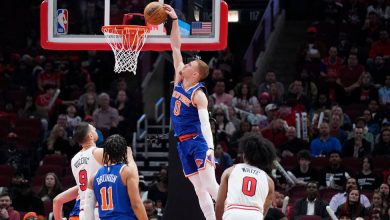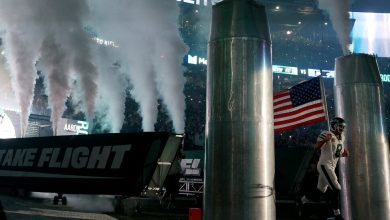College Football Playoff Rankings Are an Ode to the Power 5

If the Cincinnati Bearcats were a cartoon character, they might be Charlie Brown: enthusiastically running up to kick the football only to have Lucy pull it away at the last minute and landing — once again — on his back with a thud.
The program that Luke Fickell, the former Ohio State assistant, has meticulously built seemed to have risen to meet a moment on Tuesday night when the College Football Playoff committee announced its initial rankings of teams vying for a spot in a four-team playoff that begins on Dec. 31 at the Orange Bowl and Cotton Bowl.
The Bearcats, who play in the American Athletic Conference, are trying to become the first team outside the establishment — the Southeastern, Big 12, Pac-12, Big Ten and Atlantic Coast conferences along with Notre Dame, an independent — to crack the playoff since it began in 2014. They have ambitions of being the first outsiders to win a title since Brigham Young in 1984.
Cincinnati has a stout defense, led by Darrian Beavers, a semifinalist for the Butkus Award as the nation’s top linebacker, and a potent offense, led by Desmond Ridder, a savvy and shifty quarterback. Both are fifth-year seniors and their steady development has mirrored the program’s rise.
The Bearcats are unbeaten this season, at 8-0, including a decisive 24-13 win at Notre Dame, which snapped the Irish’s 26-game home winning streak. They had climbed all the way to No. 2 in The Associated Press Top 25 poll. And as if to confirm that they are not interlopers, many of these some players remain from a year ago when the Bearcats’ only loss during a season shortened because of the coronavirus pandemic was in a bowl game to Georgia — this year’s No. 1-ranked team — on a last-second, 53-yard field goal.
But when the 13-person committee — made up of college administrators, former coaches, former players, a businessman and a former sportswriter — revealed its first rankings, it was as if Lucy had yanked the ball away. Thud. Cincinnati landed sixth. Ahead were one-loss Alabama (second), unbeaten Michigan State (third), Oregon (fourth) and Ohio State (fifth).
“It’s essentially a P-5 invitational,” Mike Aresco, the A.A.C. commissioner, said in a phone interview on Tuesday night, referring to the Power 5 conferences. “If Alabama was in our conference and won all their games, do you think they would be ranked sixth? I don’t think so.”
There is always going to be something to quibble about with a process that is so subjective and absent any sort of transparency. There is no sense of what kind of debate goes on in the room over two days of hashing out a top 25 — only the committee chairman, Gary Barta, the Iowa athletic director, is permitted to address the media. Rarely is the chairman illuminating.
In large part, this stirring of the pot is an essential ingredient in college football — no different from when Miami and Washington, and Colorado and Georgia Tech split national championships in the ’90s; when Colorado obliterated Nebraska and was left out of the title game in favor of the Cornhuskers in the early 2000s; or when Alabama got a rematch with Louisiana State nearly a decade ago.
Controversy is good for the brand, and so are the brand names. (Don’t underestimate the invisible hand of ESPN — which has the broadcast rights to the playoff and the weekly reveal show over the next five weeks — in influencing the semifinal matchups.)
That may help explain why Alabama, with its championship pedigree and a loss at Texas A&M, was slotted at No. 2, leaving open the possibility that a respectable loss to Georgia could make the Crimson Tide the first team to reach the playoff with two defeats.
Barta said the Alabama decision was not difficult. “It was a strong consensus,” he said.
That Cincinnati was ranked No. 2 in the polls was immaterial, said Barta, who added that the Bearcats didn’t have any significant victories besides Notre Dame and that they had played lackluster football for the last two weeks in victories over two-win Navy and one-win Tulane.
That assessment is certainly true. But it’s also not a standard to which others are held.
The Bearcats don’t play in a conference with the weekly rigors of the SEC or the Big Ten. But they had beaten Indiana more decisively than Michigan State had (Michigan State needed to rally to win in the fourth quarter). Cincinnati also defeated Miami (Ohio) far more forcefully than Minnesota, which is leading the Big Ten’s West division. And that sluggish win at Tulane was far more comfortable than Oklahoma’s home win over the Green Wave, which wasn’t assured until a last-gasp quarterback scramble on fourth-and-13 came up a foot short.
All of this does lead one to wonder how much of a gap there really is between the A.A.C. and the best teams in the country. Memphis, a middling team in the American Athletic, beat Mississippi State, which is ranked 17th by the selection committee. Tulsa, another pedestrian A.A.C. team that visits Cincinnati on Saturday, was leading in the fourth quarter at Oklahoma State, which is ranked 11th. It was also within 27-20 and threatening in the fourth quarter at Ohio State before being turned back.
So, with Southern Methodist and Houston being unranked — both one-loss teams that could bolster Cincinnati’s ledger in the next month — the best chance for the Bearcats to climb into the top four without being leapfrogged themselves is to keep stacking up victories, look good doing it and hope for chaos all around them.
“What you sense is frustration,” said Aresco, a former member of the selection committee, as he became increasingly exasperated over the phone. “We kind of run into the same issues. I don’t think there’s enough nuance. I don’t think our best teams are given enough credit for how good they are. Cincinnati is a good team and proved it, just like Houston did and just like Central Florida did.”
Houston finished 13-1 and ranked eighth in 2015. Central Florida won 26 in a row in 2017 and 2018 but never rose higher than seventh in the committee’s rankings. Neither of them had the type of marquee regular-season win that Cincinnati had at Notre Dame.
“It’s like the goal posts move every time,” he said. “There’s a lot of things that don’t make sense.”



